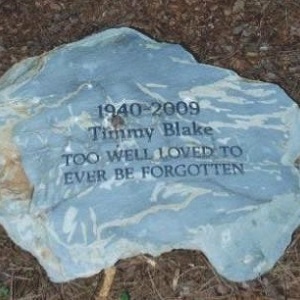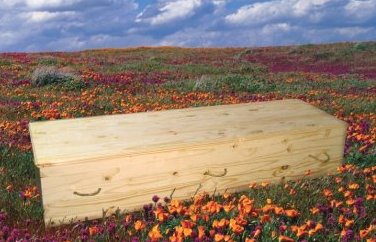
"From cradle to grave" is a metaphor often used for the environmental impact of a manufactured product, from the energy and resources for its initial manufacture, to the kind of waste it eventually becomes when its discarded.
It's a an even apter metaphor for the impact of a life, from what kind of nappies you used as a baby, right up to disposal of your final waste product: your corpse.
So how green are the different options?
Burial: our overcrowded cemeteries
Burial, in South Africa as in most countries, remains the most popular end-of-life choice, and is the most commonly used by members of Islamic, Christian, Jewish and traditional African faiths.
Many cultures believe that burial is the most respectful way to treat the dead body, and find comfort in having a specific gravesite for family and friends to visit.
The primary drawback to burial is that it requires space. With population growth and the death toll from HIV/AIDS, our cemeteries are rapidly filling up. The scope for new sites is extremely limited. And, once a cemetery is full, it tends to become, quite literally, dead space, in that it has no future alternative function. Also, conventional cemeteries require considerable upkeep and resources to maintain them as the tidy, tranquil havens they are intended to be.
In other ways, too, modern burial is environmentally unfriendly. In addition to the resources and pollution involved in manufacturing them, coffins are often elaborate affairs that introduce potentially harmful substances into the soil, such as solvents and glues, and non-biodegradable elements like metal plaques.
Embalming, which preserves the body prior to burial with injected chemicals such as formaldehyde (a carcinogen), introduces yet more toxins.

Cremation: space-efficient but toxic
Cremation doesn’t require cemetery space, and it’s cheaper than burial. But crematoria do contribute to air pollution, releasing toxins such as formaldehyde, hydrogen chloride, dioxins and mercury, and the combustion process adds to greenhouse gas emissions. Incinerators also require fairly high amounts of energy.
Ashes themselves are thought to have little impact on the environment, and can be scattered practically anywhere – the law here doesn't restrict this, says Theo Rix, managing director of Independent Crematoriums of SA, which allows you broad scope to choose a place with special significance.
Less harmless than ashes is funereal litter: items such as artificial wreaths and non-biodegradable crematorium urns, especially when cast into water, are not a positive addition to the environment.
Towards a greener death
In parts of the world, such as the United Kingdom and United States, the green or natural burial movement has been working for several years now to reform how we return to dust and ashes. Green burial aims to have as low an impact on the environment as possible, and to create sites that become a natural asset rather than the sterile, grim places traditional cemeteries often are.
With natural burial, bodies are not embalmed, coffins are simple and made of easily decomposable, non-toxic materials, and trees, shrubs or rocks are usually preferred to traditional headstones.
Generally, the more elaborate and expensive the coffin, the longer it takes to biodegrade. As long as the coffin is sturdy enough to transport the body and not leak body fluids, a coffin can be made of just about any materials.
Greener models include coffins made of sturdy cardboard, which breaks down rapidly in soil, and is often made from recycled materials. Other environmentally friendly materials include woven branches, wicker, bamboo and papier-mâché. Some people make their own coffins, or commission a craftsman. A shroud, made from sufficiently strong natural fabric, is another option.

A woven shroud is a greener burial alternative used by many cultures for centuries. This modern version is by Kinkaraco Green Burial Products.
Our first green burial site
South Africa's first green burial site was established a couple of years ago near Stellenbosch in the Western Cape: the Wiesenhof Legacy Park, a 300-hectare privately-owned nature reserve, which offers burial plots and memorialisation areas for ash scattering.
The site's indigenous vegetation creates a natural habitat for wildlife, which includes zebra and springbok, and only 10 hectares will be used for burials. "While traditional cemeteries have up to 80% of a site covered with graves, our difference is conservation,” says CEO of Legacy Parks, Willie Fouche.
Bodies and ashes will be interred in caskets made from biodegradable materials such as wicker, and burial sites marked only with simple, flat stone markers or trees planted by relatives. Ashes can be scattered together with wildflower seeds.
It's not cheap to buy space at Legacy Parks for your final resting-place: an ash scattering costs around R1 500, while a prime plot goes for R28 000. On the other hand, as the Legacy Parks managers argue, traditional burial isn't cheap either: a typical funeral including an ostentatious coffin and headstone can easily set you back around R30 000 or more.
Wiesenhof Legacy Park also has the advantage of being a secure venue; several graveyards in South Africa have become too dangerous for family members to feel safe to visit.
Further green options
If you’re fortunate enough to own land yourself in the countryside, you could decide to be buried there. Requests for burials on small-holdings and farms, which often have historical family graveyards, are not uncommon, says Rix:
“You need to apply to Home Affairs for a funeral certificate that will legalise such a burial. Your funeral director can help you organise this. As long as certain requirements are met, such as digging the grave at least six feet down, and making sure there won’t be contamination of water courses, most such applications get the go-ahead.”
Burial at sea – preferably in a weighted, biodegradable shroud or simple coffin – is also worth considering.
Donate before you bury or cremate
Just because you won’t be using your body any more doesn’t necessarily mean someone else can't: donating your organs or tissues to allow another person to live really is the ultimate in recycling. Here’s how to become an organ donor:
- Anyone under age 70 not suffering from diabetes, hepatitis, cancer or HIV/AIDS can be a donor. Costs of the procedure are covered by the hospital or state.
- Discuss the decision with your next-of-kin, as they must give approval to have your organs removed upon your death.
- Call the Organ Donor Foundation’s toll free number (0800 22 6611) to register. You’ll receive a donor card, and stickers for your ID document and driver's licence.
- You can specify which organs (heart, lungs, kidneys, liver, pancreas) or tissues (corneas, heart valves, skin, bone) you’d like to donate.
- Once you’ve been declared brain-dead by two independent doctors, the specified organs and/or tissues are removed, and the body returned to your family. The procedure doesn't disfigure the body, which can be buried or cremated like any other.
- If you change your mind about donation, simply tear up your card, remove the stickers and inform your family.
Contribute to science
You can also donate your entire body to a university for research or training medical students. Some people don’t relish the idea of fledgling doctors poking and prodding their remains, and possibly not treating them with due respect (we’ve all heard those medical student stories); nonetheless, there is no equivalent substitute for this indispensable teaching tool.
The Department of Anatomy and Histology at the University of Stellenbosch, one of many universities that allow people to become cadavers, explains the procedure as follows:
Most cadavers are unclaimed bodies, but if you’re interested, you can contact the Department and they’ll send you a brochure and application form.
At death, the university collects the body as soon as possible and embalms it. Bodies must be free of contagious diseases, and within a 60 km radius of the medical school, otherwise the university won’t collect the body. The Department strongly advises that your will should not state that you’d like to donate your body to science, because this is legally binding and could have major implications if you are abroad at the time of death. You must state that it is only binding if you die a certain distance from the specified university.
New options on the horizon
Freeze-drying corpses is a process mainly under development in Germany. The body is frozen in liquid nitrogen, then broken up into tiny fragments by vibration. Any metal is removed and the freeze-dried organic particles can be buried with no threat to the environment.
Aquamation, which has been introduced on an as yet small scale in Australia, uses a process called alkaline hydrolysis to dissolve the soft tissues of the body. The softened bones are then crushed and can be buried with minimal environmental impact.
Green or just cheap?
If you’re concerned that your green funeral will appear "cheap", then stress the socio-environmental benefits – make it clear that your wishes have to do with heartfelt ideals and concerns. Make up for any material lack by paying attention to details of the ceremony; this will mean far more ultimately than velvet linings and brass handles.
- Olivia Rose-Innes, EnviroHealth Editor
@OliviaRoseInnes
Post a question on the EnviroHealth Expert Forum




 Publications
Publications
 Partners
Partners









